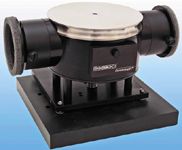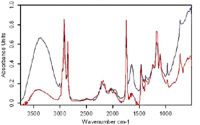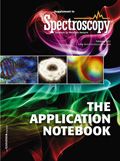Multiple Reflection Diamond ATR Spectroscopy for Analysis of Pastes and Microvolume Samples
Diamond is generally not used as a multiple reflection ATR element due to its strong lattice bands around 2200 cm-1M.
Susan Berets and Jeffrey Christenson, Harrick Scientific Products, Inc.
Diamond is generally not used as a multiple reflection ATR element due to its strong lattice bands around 2200 cm-1. However, its refractive index, high degree of chemical inertness, and low coefficient of friction make it ideal for this application. This note explores the use of a multiple reflection diamond ATR accessory to measure infrared spectra of several pastes.
Experimental
A small CVD-diamond was mounted in the Harrick ConcentratIR™ (see Figure 1) in place of its standard silicon ATR element. This diamond ATR configuration supplies 15 reflections from the sample. For analysis, the ConcentratIR™ was installed and aligned in a commercial FTIR spectrometer. Spectra were collected at an 8 cm-1 resolution and signal averaged over 32 scans. Two samples were investigated: Land O' Lakes Butter and Fleischmann's Original Soft Spread. Both samples were smeared on the ATR crystal for analysis.

Figure 1: ConcentratIR⢠Multiple Reflection ATR.
Results
Figure 2 shows the spectra of both samples. It is clear that butter and margarine both have features from cis and trans fats. The band around 3010 cm-1 is indicative of the C-H stretch of a cis double bond, while the peak around 990 cm-1 is characteristic of the trans double bond. The two spectra also show an O-H stretch around 3300 cm-1. Based on the exact position and shape of those bands, the margarine probably has greater water content than the butter. Note that there is increased noise in the 2400–1800 cm-1 region due to incomplete subtraction of diamond lattice bands.

Figure 2: Multiple Reflection Diamond ATR spectrum of margarine (blue) and butter (red).
Conclusion
In summary, diamond can be effectively used as a multiple reflection ATR crystal to examine materials such as pastes, slurries, and liquids, as long as the analytical bands do not overlap the strongest absorbance bands of diamond. The ConcentratIR multiple reflection ATR has a very small sample volume, making it a useful tool for studying microvolume samples.

Harrick Scientific Products, Inc.
141 Tompkins Ave., 2nd Floor, Pleasantville, NY 10570
tel. (914) 747-7202; fax(914) 747-7409
Website: www.harricksci.com

Real-Time Battery Health Tracking Using Fiber-Optic Sensors
April 9th 2025A new study by researchers from Palo Alto Research Center (PARC, a Xerox Company) and LG Chem Power presents a novel method for real-time battery monitoring using embedded fiber-optic sensors. This approach enhances state-of-charge (SOC) and state-of-health (SOH) estimations, potentially improving the efficiency and lifespan of lithium-ion batteries in electric vehicles (xEVs).